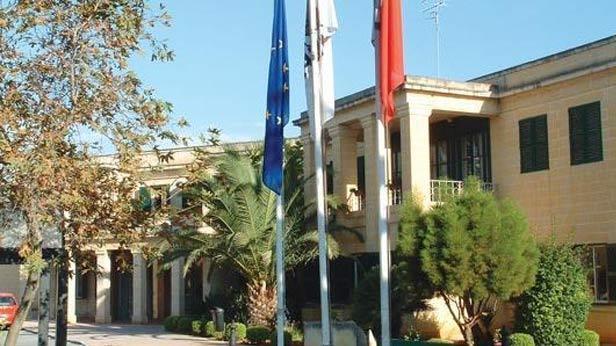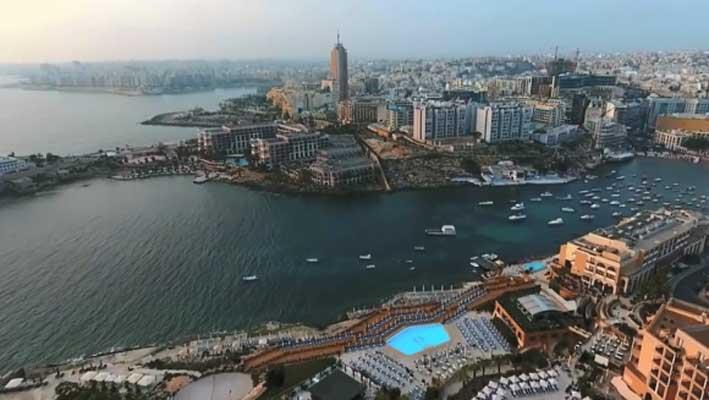The Planning Authority’s Executive Chairperson, Martin Saliba, does not believe that the authority has the right to deny pencil developments, despite them being eye-sores.
Saliba was being interviewed by The Malta Independent on Sunday and, among other things, defended the authority against recent criticism that he had a conflict of interest while sitting on the Environment and Planning Review Tribunal (EPRT), given that he was on unpaid leave from the Planning Authority (PA) at the time. He also spoke about high-rise development and the overall look of buildings in Malta.
In the interview, Saliba stated that the biggest criticism the PA receives is not over the quality of architecture - which he believes has improved – but rather over pencil developments. Such situations occur where there is low density development, yet the plans for the area allow for high density development.
“As an example, there would be a row of plots and the owner of one decides to build five floors, which the relevant plans and laws allow for. The other buildings would currently, however, be two floors. That creates a pencil development that, when looking at it, is an eye-sore.” He does not believe that the PA has a legal basis to stop such development if plans and policies allow it. He said that even the courts gave the PA indications that if the applicant has a right to build it then the applicant cannot be stopped.
“One can possibly, in the future, look into whether such applications can be stopped by saying that while potential for development exists, it must be done more comprehensively and so we would no longer look at individual plots but at whole blocks. In my opinion, however, it is a bit too late in the day to change things when many such buildings have been spread around the country since the 90s."

He was challenged over criticism levelled against the PA regarding the hotchpotch developments that have been allowed over the years and was asked whether he believes this is an issue of planning laws, or of the PA requiring more freedom in its decision making process.
“The fact that we have multi-ownership means everyone comes with their architectural expressions and designs,” he said. “Planning policies are there to try and amalgamate and integrate different buildings, but there is still variety.”
Saliba said that, when looking at an application, the PA would be looking at how a site, road or block is planned and what is permissible, and finally when the area one day comes together, it does so generally. As an example he said that Sliema front, at one point, was made up of two floor villas. “Back in the 80s plans changed to allow 8 storeys. Gradually the area physically changed and today we have a row of buildings that rose and merged into a front of 8 storeys. As for whether one likes it or not, that is a question of taste.”
Regardless, Saliba said, he feels that certain architectural aspects and how architecture is integrated into the streetscape should be considered. This, he said, should start from the architects, who need to guide their clients.
“On our part, we have policies, conditions and parameters in terms of size, volumes etc. So in some way or other we try to control it, but at the end of the day it is according to each individual application that permits are granted. It is a piecemeal approach,” he said.
Asked whether he thinks this needs to change, he said that he wants to see more assessments of streetscapes.
“That is why we ask for photos, expanded views of the streetscape. It also depends on the locality. So when it comes to Urban Conservation Areas, they go into these aspects more so than in other zones that are within the development zone. Maybe one can extend that approach, which is more stringent in a way, to other urban zones.”
Asked whether a change in law would be required for this to happen, he said “not necessarily, as there are policies that go into such aspects.”
He said, however, that one might need to go into more detail in terms of how an application is assessed, and the boards that decide on applications might need to have more ways and means to impose certain conditions. “They do impose many a time,” he clarified.
"We can extend the aspects that we delve into more detail in UCA applications to other urban zones."

Prior conflict of interest
Prior to taking up his post as PA Executive Chairperson, Saliba was Chairman of the Environment and Planning Review Tribunal. Recent news reports read that Saliba, while working for the Environment and Planning Review Tribunal, was actually out on unpaid leave from the PA where he was stationed prior, raising conflict of interest concerns. “Don’t you see that as having a conflict of interest? You would decide on appeals about cases that the Planning Authority would have taken a decision on while still being employed by them,” he was told.
“I reflected a lot on this. I did not have any conflict. I exercised my right to go out on unpaid leave like every public officer in the civil service who, if they are going to move, have the opportunity to go out on unpaid leave. I did not have any other contract with the PA.”
He said that he did this so as not to have any ties to the PA. “There were other means by which I could have remained employed with the Authority, and there it would have created issues.”
“I essentially left the authority while holding the right so that, if I wanted to go back, I could without a call for applications,” Saliba said.
“I never felt that I had some ties or was in some way conditioned by the PA. I had terminated my work with the PA and began a new job with the tribunal. I was loyal to the tribunal, paid by the Tribunal, through the consolidated fund. So I had no ties.”
This newsroom pressed Saliba, highlighting that justice needs to be seen to be done, asking whether he believes the people who went before the tribunal had a right to know about his situation.
In response, he said that people do not understand how the PA works. He said that the people taking the decisions on applications have no relation to the workers at the PA. The people who sit on the PA boards or commissions deciding on applications do not have any administrative or executive functions, he added.
He said that the Planning Board would overturn the recommendations of case officer's for example, adding that the boards do not have control over case officers.
Pressed further as to whether he thinks those who went before the tribunal had a right to know that he was on unpaid leave from the PA, he said “I didn't need to and didn't feel I had to as I was not part of the PA. When I left the PA, I left. For me, that was my position, that I left the Authority.”
He said that the fact that members form part of the tribunal for a definitive period, means there is an element of not knowing what they will do afterwards, “and some are there part-time.”
“At the end of the day the tribunal is made up of members who, subjectively, can have an element of partiality, if we want to expand the argument. But there is trust in the members that they are impartial and that while deciding, are putting aside any influence they may have in their profession.”
“I felt more at ease as I had no ties with a company, firm or private office.”

Malta's skyline
The discussion then turned to Malta’s skyline, and criticism that it is not really being taken into consideration given the high-rise developments taking place.
He was asked whether there needs to be a proper plan or policy for Malta's skyline, and he said that this would be ideal.
When looking at an application, he said, he sees what is allowed as per the relevant plans, not what is currently there. “People who are versed in the planning system understand that the skyline is changing. We knew this even when the local plans were designed. The local plans had already established certain height parameters that came, at the end of the day, from older plans and schemes."
"We haven't really changed much in the way we are planning and building. The way permits are issued, in terms of their foundations, did not really change there is the zoning, land use and building height. The building heights that were established, established a kind of skyline.”
“Take Manikata for example. It changed way back in the 90s where, instead of two floors, they decided to allow three. So across the board a storey was added. Then people interpreted the ability to have penthouses and they were given through a policy. So the local plans established a certain height which reflected, most often than not, the permits and the way building heights were established between 1992 and 2006. There was little change.”
Turning to high-rise developments, he said that the FAR policy reduced the zones where such construction could take place.

“The impact of towers on the skyline is evident, but it is a question of how one looks at high-rises. In my opinion, such a building can ameliorate a zone as, while raising the height would create spaces and create elevations. So no matter where you see a high rise from, you are enjoying its view, in a way. This would be different from building plots in zones where you would just see facades," he said.
He said that there are zones that require regeneration. “I am not saying that high-rise buildings will solve the problem, but through the element of how we build, by building vertically, maybe we can create more pedestrian spaces. This has its advantages."
He said that there might be the perception that by increasing development vertically, then they are increasing floorspace. "Floor space has nothing to do with it as if you build horizontally according to the local plan, or vertically, the floorspace will remain almost the same, if not less."
"The impact of height on the surrounding area is also a question of context."
He said that high rise buildings are being concentrated in the Sliema, St Julian's, Gzira area.
This newsroom pointed out that the high rise construction in Sliema and St Julian’s will have a major impact on traffic.
He said that the traffic issue is tied to the commercial and floorspace elements.
"When you change the nature of development, whether you build conventionally or through high-rise, it has roughly the same impact."
"So if I build a supermarket on 1,000 square metres, or build the same supermarket on 200 square metres but then raise five floors, it has the same impact.”

Transport
He was asked about traffic generation by the high-rise buildings given that the roads in St Julian's cannot really be widened.
“The demand for development has increased. Instead of having more gradual development, it was rapid. Traffic management was still going to be a challenge. We must remember that the population has increased, that the number of cars increased. So it does not mean that a development has increased the amount of traffic substantially on its own.”
He said that Paceville is an attraction, even without the high-rise buildings as only Portomaso is in use thus far. He said that the area already has traffic concentrated.
Told that the high-rise buildings will add on to the traffic concentration and not doing anything to solve the traffic problem, he said that the government is addressing certain aspects in terms of junctions etc. He added that the St Andrew's road issue, for example, needs to be solved.
There are other options, Saliba explained. “Even the mode of transport needs to change. We have been working too long on the traditional idea of using a car. We need to think out of the box, to see how, while we are increasing the quality, attractiveness and tourism aspect in that zone which helps generate the economy, the government needs to start thinking about how the mode of transport needs to change.”
He mentioned Valletta and the park and ride system as an example.
“The point is that If you are going to create parking in the middle of a centre, then you will create an element of traffic generation. This is not needed. So make space for the cars further out, increase public transport and transport alternatives. This is needed in the Sliema, St Julian's area. The moment has come. The development that it taking place and that is being planned, needs to be compensated with different transport modes."